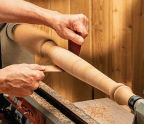
For perfect crosscuts, it’s hard to beat a miter saw. But when workpieces are too wide for a miter saw — or worse, you don’t have the funds or room for one — a table saw and miter gauge are your best friends. But you can do even better with a dedicated crosscut sled. It’s constructed from the start with a dead-on right angle, so you’ll never adjust a finicky miter gauge again. Plus, stock is supported on both the bottom and rear edge, meaning no table friction on the workpiece for easier control and splinter-free cuts.
Because of this support, augmented with adjustable hold-downs, crosscutting is safer, especially for workpieces too small for a miter gauge. If you add a T-track flip stop on the rear fence, effortless repeatability will be built in.
Material and Sizing
You can use any engineered sheet material — solid wood is too prone to warping — with 3/4" Baltic birch plywood typically being the go-to stock for sleds. Regular ply and MDF are other options.


For rigidity, the front and rear fences should be thick. They’ll hold the sled together after it’s essentially sliced in half. Here, we’ll laminate two pieces of 3/4" ply together for 1½"-thick fences.
This sled’s 3/4" base is thick enough to incorporate T-tracks for hold-downs, but if you’d prefer a lighter, more basic sled without T-tracks, you might opt for 1/2" plywood for the base instead.
Sleds can be any




